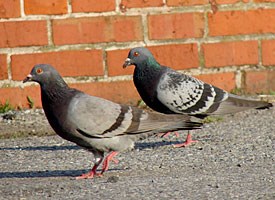
A common sight in cities around the world, Rock Pigeons crowd streets and public squares, living on discarded food and offerings of birdseed. In addition to the typical blue-gray bird with two dark wingbars, you'll often see flocks with plain, spotted, pale, or rusty-red birds in them. Introduced to North America from Europe in the early 1600s, city pigeons nest on buildings and window ledges. In the countryside they also nest on barns and grain towers, under bridges, and on natural cliffs.
Cool Facts
Pigeons can find their way home, even if released from a distant location blindfolded. They can navigate by sensing the earth’s magnetic fields, and perhaps also by using sound and smell. They can also use cues based on the position of the sun.
Mesopotamian cuneiform tablets and Egyptian hieroglyphics suggest that pigeons were domesticated more than 5,000 years ago. The birds have such a long history with humans that it's impossible to tell where the species' original range was.
Rock Pigeons carried messages for the U.S. Army Signal Corps during World War I and II, saving lives and providing vital strategic information.
Charles Darwin kept pigeons for many years after returning from his five-year voyage on the Beagle. His observations on the great variety of pigeon breeds, and the huge differences found between captive breeds and wild pigeons, helped him formulate some aspects of his theory of evolution.
Pigeons come in many different shades and plumage patterns. People have named some of the common forms, so keep an eye out for these varieties: The typical “blue-bar” form (a bluish-gray bird with two black bands on the wing and a black tip to the tail); a “red bar” version (similarly marked, but with rusty red replacing bluish gray); “checker” (birds that have spots on the wings); “spread” (all black or all gray); “pied” (birds of any color that are splotched with white); and mostly red or mostly white forms.
One domestic homing pigeon, a “retired” U.S. Army Signal Corps bird named Levi, lived to be 31 years old. Feral Rock Pigeons have shorter life expectancies, averaging only 2.4 years. However, a Kansas bird was 6 years, 2 weeks old when it was recaptured and rereleased.
Hi! I am a robot. I just upvoted you! I found similar content that readers might be interested in:
https://www.allaboutbirds.org/guide/Rock_Pigeon/lifehistory
Downvoting a post can decrease pending rewards and make it less visible. Common reasons:
Submit
@tamimiqbal has upvoted on this post with a reply. If you want to receive upvoting on your all post, just simply follow @tamimiqbal
Best regards
Tamim Iqbal
Downvoting a post can decrease pending rewards and make it less visible. Common reasons:
Submit